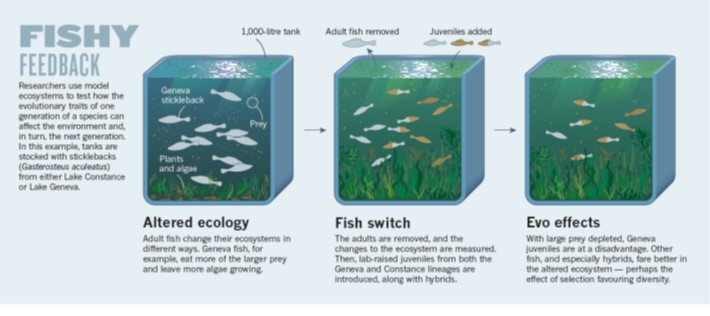How do ecology and evolution interact to produce the trait variation we see today?


Evolution can happen much more quickly than ecologists have traditionally appreciated – making it a constant source of changes to the trait diversity contributing to community composition and function. For example, work with stickleback fish shows divergent adaptations to marine, lake, or river habitats that can appear in little over 100 years (under 100 generations). These trait differences between lake and stream fish can impact how they feed and recycle nutrients, with impacts on aquatic ecosystems from plant growth to invertebrate production. Even more interesting is that these ecological changes can then feed-back to alter which types of sticklebacks do best in subsequent generations (potentially leading to further evolution). Although sticklebacks are frequently used as a model system for basic
questions in ecology and evolution, these findings also have direct implications for conservation questions: in central Europe, multiple lineages have been introduced by humans, and are now both interacting with native fish and hybridizing with each other, impacting broad scale trajectories for trait diversity in Swiss fish communities.

Publications:
Best, R.J., J. M. Anaya-Rojas, M. C. Leal, D. W. Schmid, O. Seehausen, and B. Matthews. 2017. Transgenerational selection driven by divergent ecological impacts of hybridizing lineages. Nature Ecology & Evolution 1:1757-1765. link | read here. Featured in Nature piece on eco-evolutionary feedbacks.
Anaya-Rojas, J.M., R.J. Best, F. Brunner, C. Eizaguirre, M.C. Leal, C. Melian, O. Seehausen, and B. Matthews. 2019. An experimental test of how parasites of predators can influence trophic cascades and ecosystem functioning. Ecology 100:e02744. link.
Lürig, M.D., R.J. Best, M. Svitok, J. Jokela, and B. Matthews. 2019. The role of plasticity in the evolution of cryptic pigmentation in a freshwater isopod. Journal of Animal Ecology 88:612-623. link.
Schmid, D.W., M.D. McGee, R.J. Best, O. Seehausen, and B. Matthews. 2019. Rapid trait evolution in recently diverged predator populations impacts predator performance and prey community structure. The American Naturalist 193:331-345. link.
Limberger, R. , J. Birtel, H. Peter, N. Catalán, D.D. Farias, R.J. Best, J. Brodersen, H. Bürgmann, and B. Matthews. 2019. Predator‐induced changes in dissolved organic carbon dynamics. Oikos 128:430-440. link.
You must be logged in to post a comment.